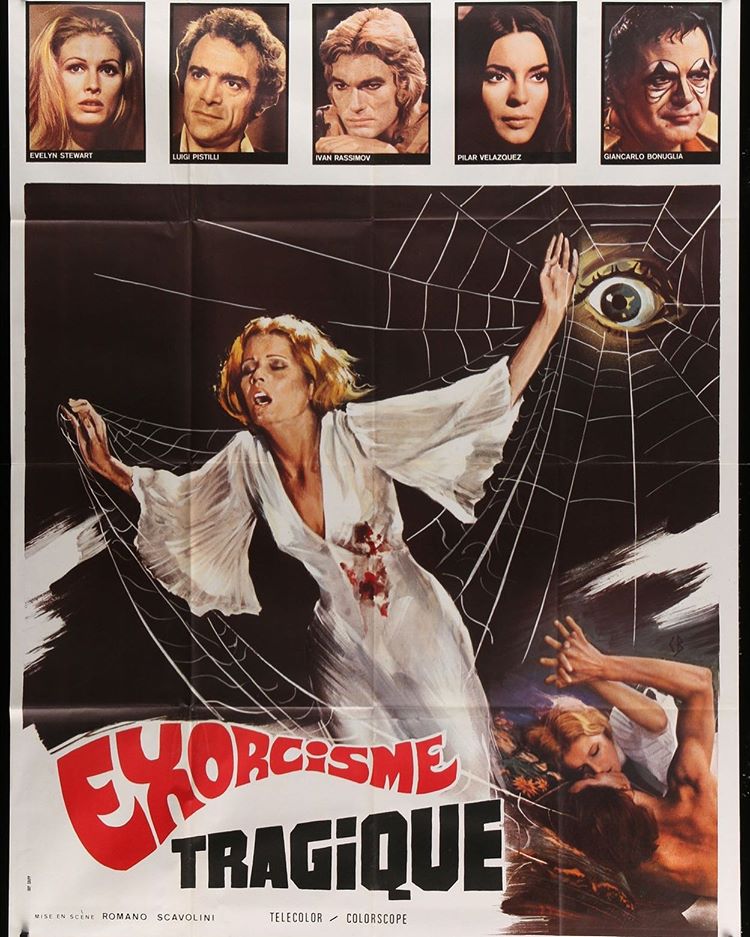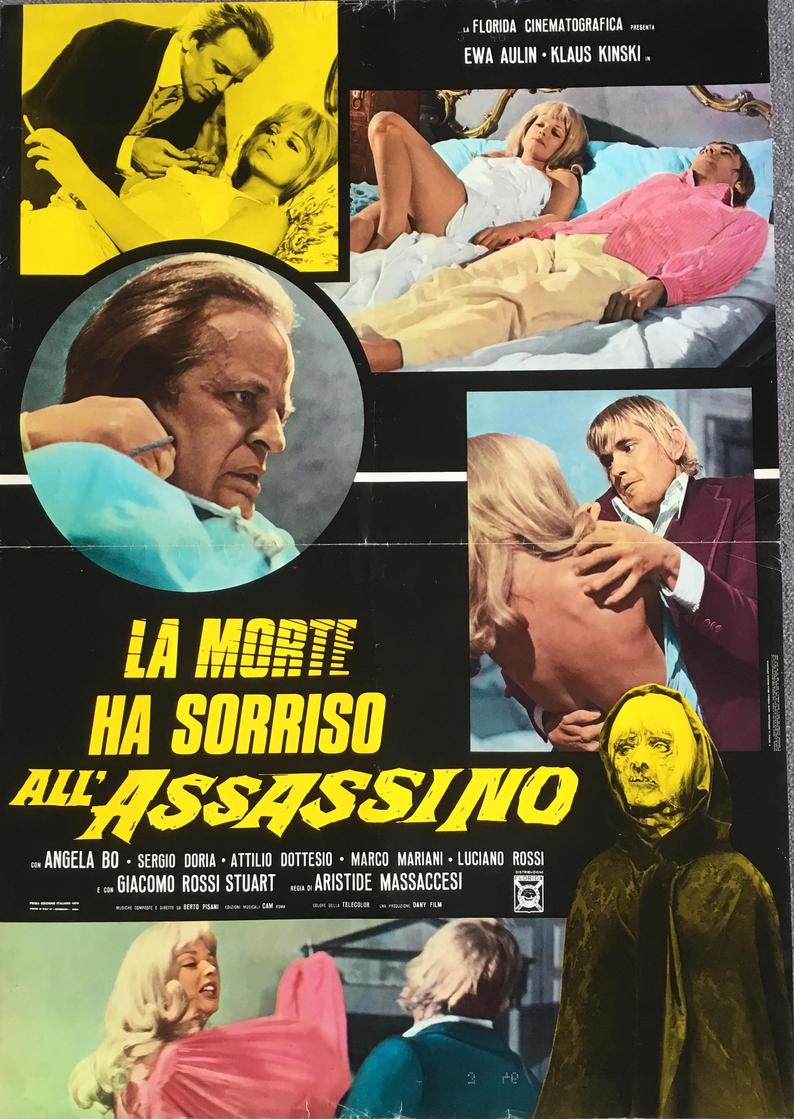A young girl-the titular Mariale-watches her father gun down her mother and a nude lover in a countryside idyll. The father then turns the gun on himself. Years later, Mariale lives in her family's crumbling castle in near-captivity, sedated by her husband Paolo and their creepy servant Osvaldo. She manages to break the lock on one of the castle's telephones and dictates a telegram, to be sent to several old friends, inviting them to visit the castle. Despite Osvaldo's initial efforts to repel the visitors, Paolo decides to let them come in, hoping to persuade them to leave at the earliest opportunity. After taking a tour of the castle, the group play an after-dinner game of Mariale's choosing, which revolves around ideas of submission and domination. They also appear to have a bit of drink taken, and things very quickly get messy, with the already-unlikable visitors revealing even more reasons to hate them. Then, finally, they start being offed one by one, until the not-very-shocking, not-very-grisly truth is revealed.
This is a pretty uneven film, although considering it was made by the same man who gave us Nightmares in a Damaged Brain a few years later, that's not really surprising. As stated above, it doesn't really succeed on any specific level, but it is worth a watch nonetheless. The cast is pretty top-notch, with Ivan Rassimov notable in that he plays by far the most sympathetic character. Maybe 'sympathetic' isn't quite the right word, but he's willing to call the rest of them out for being the unlikable assholes that they are, and he's the only character who seems capable of something approaching rational thought (ironic given that the rest of them refer to him as 'Poet' in a snidey manner). His slamming of attempted rapist Jo's "idiotic talk and dirty kisses" is shady as fuck, too.
SPOLIERS! Mariale, who is simultaneously the main protagonist and antagonist, reacts slightly differently to Jo's attempted rape of his girlfriend Mercedes-she walks right up to him and kisses him. She's set up initially as a victim-we witness the traumatic childhood murder-suicide of her parents, and then discover her years later, apparently held prisoner by a callous husband and creepy servant. We sympathise with her attempts to avoid sedation, and cheer at the success of her cry for help, achieved after she breaks the flimsy lock on one of the telephones. Why she didn't just call the police should be the first question asked by the discerning viewer, who before long will have arrived at the incontrovertible conclusion that she must be guilty of the series of murders, despite her status as possibly the most likely suspect.
NO SPOILERS! I say'before long'; that's not strictly true. The murders don't actually begin until 55 minutes have elapsed (if you discount the prologue killings). To make up for this, we're treated to a quick succession of kills for the next twenty minutes of so, none of which are top of the range set-pieces, although a dog-mauling scene is imaginatively shot with some interesting point-of-view camerawork, which doesn't intercut that well with the scene's non-POV footage. The very first murder is almost casually introduced, in a sequence which cuts between it and some softcore lesbianism, all scored to some light-hearted muzak (odd, as most of the rest of the score is nice and powerful). This-along with the lack of mystery at the heart of the plot-is one of the chief giallo failings of the film, which before that point has veered variously between gothic horror (never quite crossing into fully-fledged G.H. though) and bizarro satirical/social commentary-laden drama.
The exchanges between Gustavo and his black girlfriend Semy seem to exist to criticise a what would nowadays be referred to as 'toxic masculinity' (and racism), but on the other hand Semy doesn't help herself with some of her scatty behaviour and utterances. Scavolini also can't resist including a de rigeur 'exotic dance' scene for Semy either. Rassimov's Massimo, with whom we're most closely aligned, criticises Gustavo's behaviour (and, justifiably, that of most of the guests), which does suggest that this is one of the more socially-aware and progressive gialli. The game played post-dinner seems designed to expose the truth about human nature, specifically the selfishness and immorality which lurks just beneath the surface of respectable people with their respectable behaviour. The point is somewhat laboured, though, and could have been made in a more measured manner throughout the film, which instead moves clunkily from sequence to sequence in a stilted 'gothic scene to social commentary to murder set-piece' manner. There's a great opportunity for some early killing when the guests go exploring the tunnels in the castle's cellars-the separation of characters being a pre-requisite for murders in a single-location mystery-but Scavolini curiously passes it up, no doubt because his A to B to C formula hadn't yet reached K for Killing.
The existence of a thruple (a polygamous word for a three-person couple, keep up you squares) also hints at a progressive viewpoint, although this is undercut by the already-detailed rapey behaviour of one of the thruple's males, Jo. The other male in the triangle, Sebastiano, also covers himself in unglory when he chooses to covertly observe Jo's assault rather than intervene. In fact, Gustavo (who looks confusingly like Sebastiano) behaves in much the same manner when he stands idly by as his gf Semy tries to escape a horde of scorpions in the animal room. In both instances Rassimov's Massimo comes to the rescue, with Mariale gliding in after him to emphasise the increasing control which she's exerting on proceedings. The film could probably be seen as a treatise on the arrogance and underlying cowardice of the male, and the ability of the female to thrive when she escapes the domineering influence of the male, up to a point (the point being the final ten minutes). This interrogation of gender stereotypes is present right from the beginning, with Mariale's fully-clothed mother picnicing with a fully-nude dude.
SPOILERS! As well as gender stereotypes and behaviour dynamics, the film also somewhat investigates the effects of grief. I say 'somewhat' because while it does show that traumatic events of the past can exert an influence over present-day matters, with Mariale donning her mother's death dress to literally wear the events of the past on her sleeve, the execution-specifically, Mariale's executions-isn't exactly a nuanced representation of the effects of grief. But saying that, this is a giallo, not a Dogme film, and past traumas pretty much exist solely to provide a backstory/motive for a killer, and this film does scratch the surface of the topic more than most. It kind of has to, though, given that unlike something like, say, Bird with the Crystal Plumage, we know the identity of the trauma victim from the start, so they're never far from position numero one in terms of suspects.
NO SPOILERS! To sum up, this is a very flawed but somewhat interesting film. It's stylishly-shot (far, far, far more so than Nightmares), with the lighting on one shot which has the characters descending a staircase by candlelight being particularly impressive (most Italian films adopted a crude 'shine a torch at the actor with the candle' approach to lighting such sequences). There are also several stylish swooping camera moves, particularly during the debauched after-dinner behaviour, with the suggestion that the film is 'looking down' on its characters in more ways than one (specifically, in two ways). The music for this sequence is a thinly-veiled facsimile of In a Gadda Da Vida, a song which inspired more than one Italian knock-off. As for Scavolini, the jury's still out on him as far as I'm concerned, especially knowing the bizarre film he'd go on to create nine years later. Nightmares is either the work of a flawed genius who's decided to lower himself to making trash, or the work of someone who thinks he's a genius and has lowered himself to making trash. Or maybe it's just the work of a not-very-talented filmmaker who's prone to occasional flashes of eccentricity/inspiration. A White Dress for Mariale brings us no closer to solving that mystery, so kudos to Scavo for at least giving us one tough-to-crack puzzle.


 RSS Feed
RSS Feed
